Abstract
STUDY OBJECTIVE--To examine the use of deprivation indices in relation to health. DESIGN--This paper reviews selected publications which illustrate the diversity of use of deprivation indices in the past decade. Most of this work is based in the major routine databases which exist in this country: the census, population, mortality, cancer register, and health service records all now incorporate a postcode identifier which permits the derivation of data at small area level, and thus the examination of health events in relation to the characteristics of that area - usually ward or postcode sector. The small area approach provides a valuable tool both in deprivation and in other epidemiological studies which examine the influence of the environment on health. SETTING--The setting is various journals and official publications. MAIN RESULTS--The link between deprivation and health has been clearly demonstrated in a number of studies, with populations living in deprived areas exhibiting levels of mortality, particularly below the age of 65, which vastly exceed those in affluent areas. In the decade 1981-91, these differentials increased in Scotland and the Northern Health Region and inequalities in health are shown to have widened. Analysis shows that particular causes of death and sites of cancer are more likely to reflect the influence of socio-economic factors. The work so far mostly shows the associations between these factors and health measures and more investigation is required into the determinants of health, which are likely to reside as much in past as in current circumstances. A measure of deprivation has proved of value in excluding the likely variation in the incidence of disease in studies directed towards determining the influence of the physical environment on populations living in the vicinity of possible harmful industrial processes. A deprivation measure has been adopted by the Department of Health as a basis for making enhanced payments to general practitioners for patients living in these areas, but the resource allocation formula for allocating funds to regional authorities has failed to incorporate such a measure in the formula. CONCLUSIONS--An area measure of deprivation has proved a valuable tool in examining differentials in health and death and is likely to prove of continuing value to health authorities in planning the delivery of health care. Future work should strive to examine the determinants of health as well as the associations, although this is unlikely to be possible through the routine databases which have provided the main basis for analysis so far.
Full text
PDF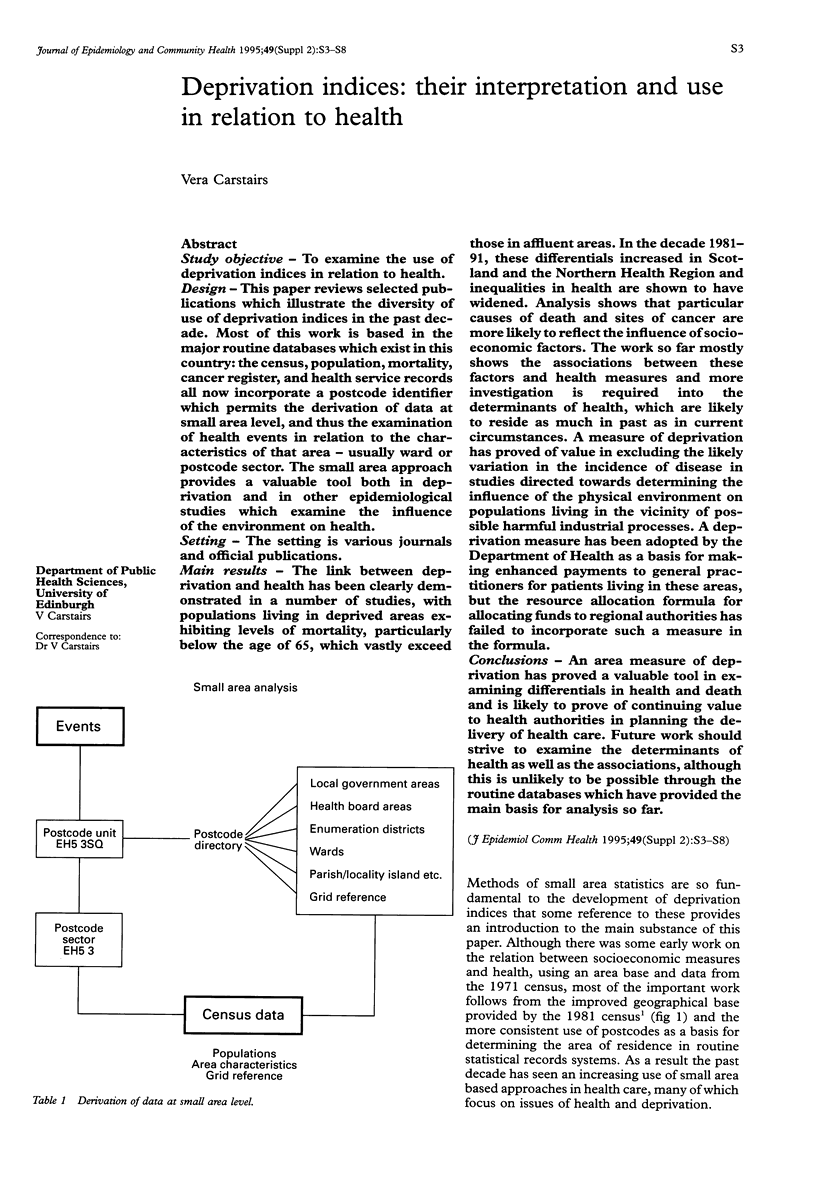
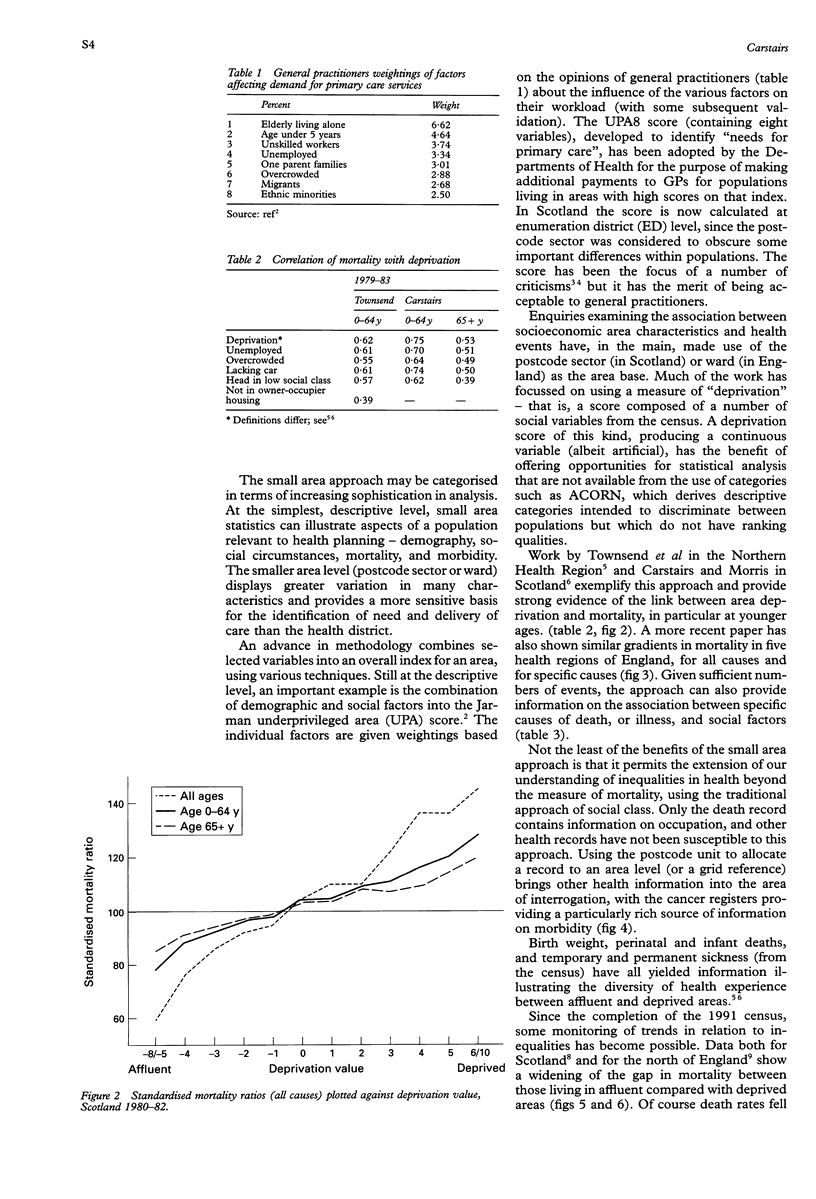
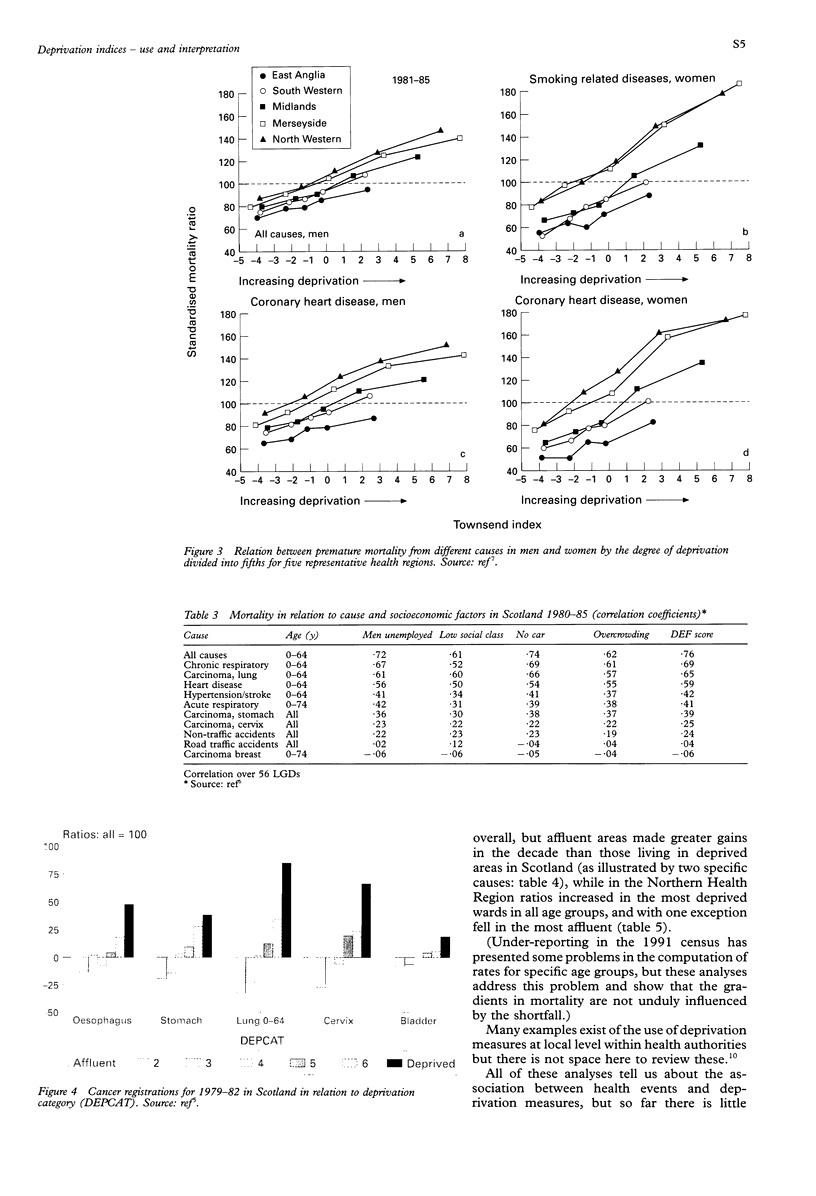
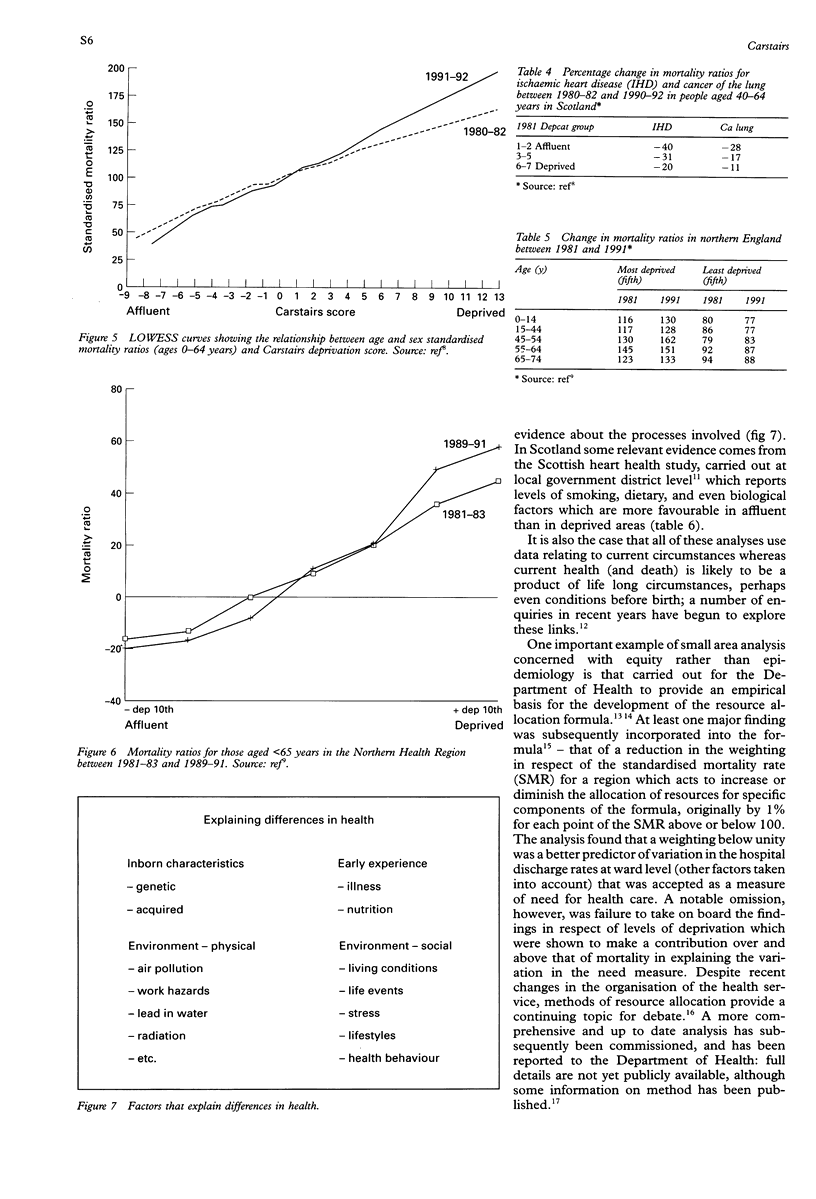

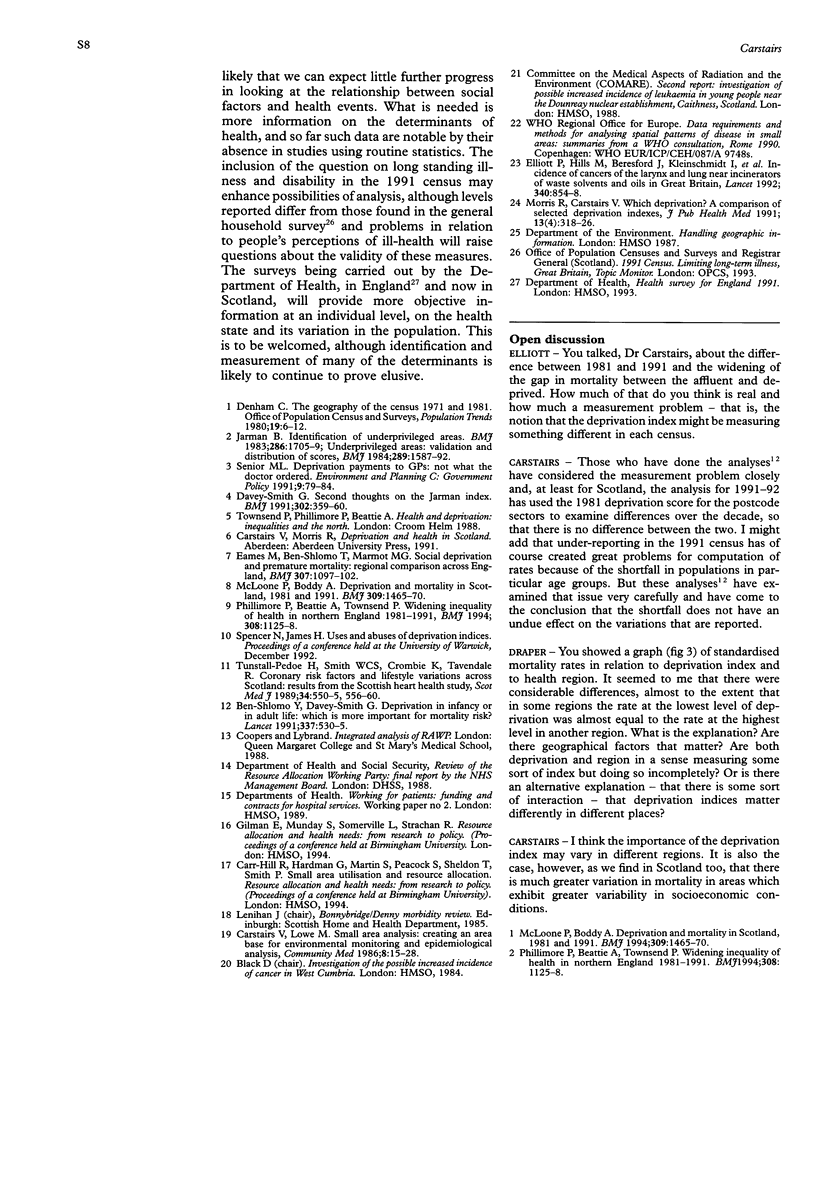
Images in this article
Selected References
These references are in PubMed. This may not be the complete list of references from this article.
- Ben-Shlomo Y., Smith G. D. Deprivation in infancy or in adult life: which is more important for mortality risk? Lancet. 1991 Mar 2;337(8740):530–534. doi: 10.1016/0140-6736(91)91307-g. [DOI] [PubMed] [Google Scholar]
- Carstairs V., Lowe M. Small area analysis: creating an area base for environmental monitoring and epidemiological analysis. Community Med. 1986 Feb;8(1):15–28. [PubMed] [Google Scholar]
- Eames M., Ben-Shlomo Y., Marmot M. G. Social deprivation and premature mortality: regional comparison across England. BMJ. 1993 Oct 30;307(6912):1097–1102. doi: 10.1136/bmj.307.6912.1097. [DOI] [PMC free article] [PubMed] [Google Scholar]
- Elliott P., Hills M., Beresford J., Kleinschmidt I., Jolley D., Pattenden S., Rodrigues L., Westlake A., Rose G. Incidence of cancers of the larynx and lung near incinerators of waste solvents and oils in Great Britain. Lancet. 1992 Apr 4;339(8797):854–858. doi: 10.1016/0140-6736(92)90290-j. [DOI] [PubMed] [Google Scholar]
- Jarman B. Identification of underprivileged areas. Br Med J (Clin Res Ed) 1983 May 28;286(6379):1705–1709. doi: 10.1136/bmj.286.6379.1705. [DOI] [PMC free article] [PubMed] [Google Scholar]
- McLoone P., Boddy F. A. Deprivation and mortality in Scotland, 1981 and 1991. BMJ. 1994 Dec 3;309(6967):1465–1470. doi: 10.1136/bmj.309.6967.1465. [DOI] [PMC free article] [PubMed] [Google Scholar]
- McLoone P., Boddy F. A. Deprivation and mortality in Scotland, 1981 and 1991. BMJ. 1994 Dec 3;309(6967):1465–1470. doi: 10.1136/bmj.309.6967.1465. [DOI] [PMC free article] [PubMed] [Google Scholar]
- Morris R., Carstairs V. Which deprivation? A comparison of selected deprivation indexes. J Public Health Med. 1991 Nov;13(4):318–326. [PubMed] [Google Scholar]
- Phillimore P., Beattie A., Townsend P. Widening inequality of health in northern England, 1981-91. BMJ. 1994 Apr 30;308(6937):1125–1128. doi: 10.1136/bmj.308.6937.1125. [DOI] [PMC free article] [PubMed] [Google Scholar]
- Phillimore P., Beattie A., Townsend P. Widening inequality of health in northern England, 1981-91. BMJ. 1994 Apr 30;308(6937):1125–1128. doi: 10.1136/bmj.308.6937.1125. [DOI] [PMC free article] [PubMed] [Google Scholar]
- Smith G. D. Second thoughts on the Jarman index. BMJ. 1991 Feb 16;302(6773):359–360. doi: 10.1136/bmj.302.6773.359. [DOI] [PMC free article] [PubMed] [Google Scholar]
- Smith W. C., Tunstall-Pedoe H., Crombie I. K., Tavendale R. Concomitants of excess coronary deaths--major risk factor and lifestyle findings from 10,359 men and women in the Scottish Heart Health Study. Scott Med J. 1989 Dec;34(6):550–555. doi: 10.1177/003693308903400603. [DOI] [PubMed] [Google Scholar]



